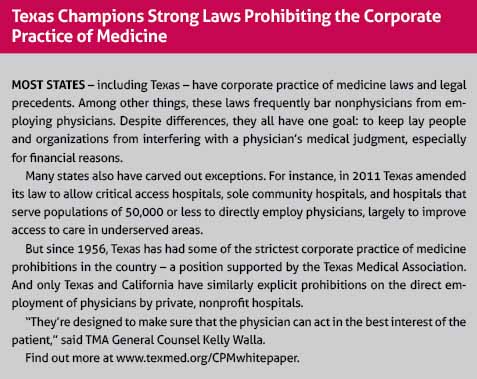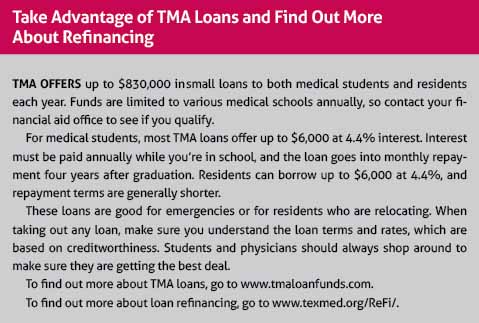
*This online version of the story has been updated to reflect a change in Department of Education deadlines and initial guidance that was learned shortly after this article went to press. The original version of this story appears in the print and digital versions of the April 2023 issue of Texas Medicine.
Texas and California have a reputation for disagreeing politically, but in medicine they work together.
Thanks to that collaboration, many Texas doctors will be able use an important federal program to reduce student debt, with the initial deadlines in that process coming soon.*
In this case, the two states found a common need to improve the federal Public Service Loan Forgiveness (PSLF) program, which was created by the College Cost Reduction and Access Act of 2007. PSLF was designed to help people who borrow lots of money to obtain professional degrees – and not just in medicine – to ease some of their loan debt burden by working full-time in public service.
The law itself did not exclude any Texas or California physicians from taking advantage of PSLF, according to Elizabeth McNeil, vice president of federal government relations at the California Medical Association (CMA), who led the joint state effort.
However, the U.S. Department of Education’s (DOE’s) 2008 rules based on the law required an applicant to, in addition to meeting other program requirements, be directly employed by a qualifying employer – for instance, by a nonprofit hospital – to get debt relief under the program, says Kelly Walla, the Texas Medical Association’s general counsel.
That direct employment requirement ran smack into Texas’ and California’s long-standing corporate practice of medicine laws, which among other things, forbid a lay corporation from practicing medicine or directly employing a physician to provide medical services. The laws are designed to preserve doctors’ independent medical judgment. (See “Texas Champions Strong Corporate Practice of Medicine Laws,” below.)
“The way that the rules had narrowly construed [the law] – that you had to be directly employed by your qualifying employer – was what was preventing certain Texas physicians from participating when they would otherwise be eligible to meet the program requirements,” Ms. Walla said.
But persistent advocacy from TMA, CMA, the Texas Hospital Association (THA), and the California Hospital Association (CHA) – combined with a desire by President Joe Biden to revamp the loan-forgiveness program – has finally prompted DOE to change the rule, Ms. Walla says. That has opened the door for Texas physicians working at private, nonprofit facilities that were previously not exempt from Texas’ corporate of practice of medicine laws to potentially qualify for the program.
Texas physicians interested in getting loan forgiveness under PSLF should keep the following deadlines in mind.*
• Physicians who work at private, non-profit facilities may begin applying to the new PSLF program on July 1, 2023.
• To be eligible for the PSLF program and to have past time worked counted towards the program requirements, physicians must have a direct government loan or consolidate their loans into a direct loan by the end of 2023. Physicians must convert any non-qualifying loans into direct loans so they can take advantage of the PSLF program, although some non-qualifying loans cannot be converted into direct loans.
Physicians with questions should contact their loan servicer, Ms. McNeil says.
Despite the lingering uncertainty about the specifics of the program, there’s no doubt that DOE’s move will be a big help for Texas physicians, says TMA President Gary Floyd, MD, who helped negotiate the change.
“It’s a big win for the docs who are in the underserved areas,” he said.

The median medical school debt in 2022 was $200,000, not including undergraduate debt, according to the Association of American Medical Colleges. PSLF was designed to encourage physicians – and other professionals – who want to ease that kind of huge debt to think about public service.
Under the plan, people in many professions could theoretically get college loan forgiveness if they committed to community service for 10 years by working in public or nonprofit organizations.
“The PSLF program also was intended to help low-income, minority students pursue careers in medicine,” Dr. Floyd said in a joint TMA-CMA letter to DOE sent May 9. 2022. “Often these students return to serve in their communities when they become physicians.”
But the promise of PSLF did not pan out for a long time. Administrative hurdles of the program were so high that the program had a nearly 98% rejection rate. Many physicians – and other public-spirited people – found themselves declared ineligible for the program.
In part because the program was so difficult to access, Texas and California physicians at private, nonprofit facilities did not realize until several years had passed that they had been excluded from the program entirely because of their states’ respective corporate practice of medicine laws, Ms. McNeil says.
In 2015, when the problem became clear to both TMA and CMA, the two associations tried to get DOE under President Barack Obama to change the rule, she says. However, President Obama was in his last year in office, and the agency’s rulemaking policy takes years to complete, so DOE declined.
At that point, the two associations tried a bipartisan fix in Congress that came close several times but could not win final passage. Finally, President Biden ordered the administrative changes necessary to make PSLF a working program. And those efforts have paid off, according to AMA. The final rules are scheduled to take effect in July, and the loan program now appears to be a viable option for widespread student loan forgiveness.
Although TMA and CMA praised the Biden administration for reforming the PSLF program, both associations were concerned that some types of Texas and California physicians would remain locked out, Ms. McNeil says. If that happened, the other 48 states could use PSLF to recruit physicians away from Texas and California. The hospital associations in both states – which generally oppose physicians on corporate practice of medicine issues – joined TMA and CMA on advocacy before DOE to encourage fixing the rule.
“I don’t think we felt the entire impact of this since the program was broken,” Ms. McNeil said. “But when they fixed the program, what we were concerned about is that we’re going to lose physicians to other states.”
That would pose large problems for Texas and California because by 2030, both states – along with Florida – already are expected to have the largest physician shortages in the U.S. because of population growth, an aging state population, and an aging physician population, according to a Feb. 6, 2020, study published in Human Resources for Health.
Texas still has important assets in recruiting physicians, Dr. Floyd says. They include a healthy economy, medical liability reforms, and – of course – strong corporate practice of medicine laws.
“With this loan forgiveness being applied, it does help us maintain advantages in recruiting physicians,” he said.

Because so much about the rule change remains unclear, it is similarly unclear how many Texas physicians will be affected, says Marcia Collins, TMA’s associate vice president for medical education.
Also, physicians will have questions that can only be answered by information DOE plans to issue later this year, Ms. McNeil says.
For instance, the places where physicians work frequently involve both for-profit and nonprofit entities. In fact, many physicians work for a for-profit physician group that helps patients at a nonprofit hospital. Which one will count toward their loan-forgiveness status?
“It gets really complicated,” she said. “But the best rule of thumb is to look at the place where physicians provide care and who owns the place – the actual, physical location.”
If the place of work is owned by a nonprofit entity, then Texas and California physicians should qualify, she said.
“However, we all need to wait for the upcoming guidance from the Department of Education, which will provide details about who qualifies and how physicians apply,” she said.
(*TMA learned shortly after this story went to press that the originally reported May 1 and July 1 deadlines for loan conversion and consolidation, respectively, were extended to the end of 2023. Details are available in initial DOE guidance that states: "Borrowers who have commercially managed FFEL, Perkins, or Health Education Assistance Loan (HEAL) Program loans should apply for a Direct Consolidation Loan by the end of 2023 to get the full benefits of the one-time account adjustment." While it is not mandatory that physicians consolidate their loans, they cannot obtain loan forgiveness without a direct government loan. This is particularly important for physicians with older loans from the FFEL program.)